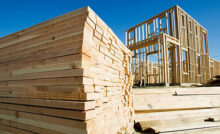Free Stair Stringer Calculator
Stair Stringer Calculator – Spreadsheet


You can download the FREE Stair Calculator here. All I ask is that you check with your local building officials to make sure you’re following the applicable building codes. Also, if you share it with others please leave the website address on it.
How To Use Stair Stringer Calculator
The free stair stringer calculator / spreadsheet is really easy to use. However, before you begin you’ll need to track down some information. You will need to following information:
- Total Height of Stairs Required – This should be the height from one finished floor to the other finished floor, measured vertically (plumb).
- Local Maximum Riser Height – This is the maximum riser height allowed by the building code. Be sure to check with your local building code official to be sure you’re current. Typically this number ranges from 7 inches to 8 inches.
- Local Minimum Riser Height – Again the building code will specify a minimum riser height.
- Local Minimum Tread Depth (run) – This is the minimum tread depth allowed by code. This is measured from the face of the riser to the face of the adjacent riser without the tread nose.
- Local Minimum Tread Overhang – This is the minimum nosing overhang measured from the face of the riser to the front edge of the nosing. This is typically limited by the building code.
- Local Maximum Tread Overhang – This is the maximum nosing overhang measured from the face of the riser to the front edge of the nosing. This is typically limited by the building code.
Once you have this information you simply enter it into the stair calculator in the blue boxes. The spreadsheet will calculate the rise and run for the stringers and show that information in the yellow boxes. It’s really as simple as that.
Stair Building Materials
Once you’ve figured out the stair geometry you should figure out what materials you’re going to use for the stairs. Stairs can be as simple as 2×12 stringers with plywood risers and treads and as complicated as steel stringers and beautiful hardwood treads.
If you plan on using wood stringers then I would recommend you at least use 2×12 lumber. Today most all stairs that I build end up using 11-7/8″ TimberStrand stringers. They are much stronger than traditional lumber and less likely to split at the apex of the tread/riser cut.
Stair Building Books


Recent Posts
Framing Stick Nailer vs Coil Nailer
Which is Better a Stick Nailer or Coil Nailer? Framers have many choices in nailers…
How Many Roofing Nails Per Square of Shingles
Estimating How Many Nails for a New Roof When it comes to estimating materials for…
Composite / PVC Decking – Layout Tips & Advice
Composite / PVC Decking Layout Tips and Advice Composite and PVC decking have really changed…
Benefits of an ERV System (Energy Recovery Ventilator)
Benefits of ERV Systems (Energy Recovery Ventilator) If you're building a new home or doing…
Vermiculite Attic Insulation Abatement
Vermiculite Attic Insulation If your home was built before 1990 there is a chance it…
Nuisance Tripping of AFCI (Arc Fault) Circuit Breakers
Arc Fault (AFCI) Circuit Breakers Tripping Often An arc-fault circuit interrupter (AFCI) or arc-fault detection…

View Comments
Nice blog. Thats all.
There are a number of primitive stair stringer calculators available on the internet. However, this one looks much more detailed; great job!
Keep up the good work,
-Matt
Stair Bracket - GoPro Construction
hope this stair calculator works. My husband has racked his brain to make the stairway in our new house have a landing without cracking your head on the floor upstairs. will let you know the outcome. Thanks.
Thanks for the advice on stair building, hopefully I don't mess this up... :)
@ Warren - Thanks for stopping by....let me know if you have questions as you work on your new stairs.
Thanks!
Thanks for the help I have a 2nd story deck which was to be a fire exit. This will encourage me to try again on the stairs.
I like this site. However, I have a question about the calculator. The code requirement in my city states that "The largest tread width or riser height and nosing depth cannot exceed the smallest by 3/8". Does this really mean I have to minutely calculate the riser height from the ground to the deck level. All the calculators seem to have the first step close to an inch lower in rise compared to the remaining step risers
Yes, you must have all steps within that 3/8". Those calculators are helping offset the flooring depths, the stringer cuts are not the final step heights.
Is there any way that this calculator could be used for a dollhouse stairs?
Should work just fine